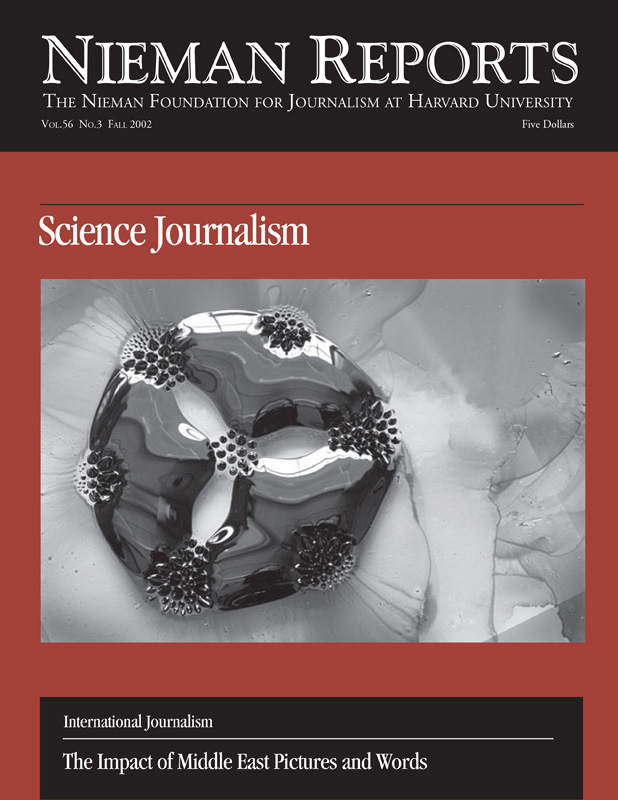As conflict in the Middle East has intensified, scrutiny of the press coverage has likewise increased, with charges of biased reporting being made from all sides. Often such charges lead to internal reviews within news organizations; some examine not only the selection of words but also the choice of photographs that tell the story in ways words never could.
In our series of stories, a photojournalist, photo editor, reader representatives, and deputy managing editor describe the decision-making process that brings photographic images from the homes and streets of the Middle East to the pages of daily newspapers, and they speak to the reaction their selections have received from readers. Courtney Kealy, a photojournalist for Getty Images based in Beirut, explains what went wrong when her provocative photograph of a Palestinian child, dressed as a suicide bomber, ended up being used for an unintended political purpose, and she shares with us recent images of Palestinian girls who have volunteered to be suicide bombers.
Randy L. Rasmussen, assistant director of photography at The Oregonian, explores the ways in which reader reaction is factored into decisions made about which photographs to publish and where to place them. He offers insight into the key questions editors ask as decisions are being made. Dick Rogers, San Francisco Chronicle readers’ representative, writes about the charges of editorial bias that photo selection engenders and tells us how he worked with a group of readers to inform his newspaper’s response. What readers told him “reminded photo editors and senior editors that day-to-day news decisions have lasting impacts on how readers view the paper.” Arizona Daily Star reader advocate, Debbie Kornmiller, developed a similar listening approach to analyzing her newspaper’s pictorial Mideast coverage and, based on readers’ suggestions, the paper made changes. Michael Larkin, deputy managing editor/news operations at The Boston Globe, explains how a particularly graphic photo of a dead child ended up on the paper’s front page.
Joel Campagna, who overseas the Middle East at the Committee to Protect Journalists, describes the dangers associated with covering the Intifada. “The situation, where the rules of engagement can change daily, poses increasing risks for those seeking proximity to the action—cameramen, camera crews, photographers and stringers in particular,” he writes. Former Boston Phoenix media critic Dan Kennedy writes about the Phoenix’s decision to link its Web site to the propaganda video of Wall Street Journal reporter Danny Pearl’s execution and to publish two photos from the video on its editorial page.
Beverly Wall, director of the Allan K. Smith Center for Writing and Rhetoric at Trinity College, works her way through “the minefield of language” that makes news coverage of the Middle East so difficult. And Rami G. Khouri, a Jordanian-Palestinian syndicated political columnist, explains why he doesn’t think that U. S. policy in the region is affected by the journalists’ selection of words and pictures.
In our series of stories, a photojournalist, photo editor, reader representatives, and deputy managing editor describe the decision-making process that brings photographic images from the homes and streets of the Middle East to the pages of daily newspapers, and they speak to the reaction their selections have received from readers. Courtney Kealy, a photojournalist for Getty Images based in Beirut, explains what went wrong when her provocative photograph of a Palestinian child, dressed as a suicide bomber, ended up being used for an unintended political purpose, and she shares with us recent images of Palestinian girls who have volunteered to be suicide bombers.
Randy L. Rasmussen, assistant director of photography at The Oregonian, explores the ways in which reader reaction is factored into decisions made about which photographs to publish and where to place them. He offers insight into the key questions editors ask as decisions are being made. Dick Rogers, San Francisco Chronicle readers’ representative, writes about the charges of editorial bias that photo selection engenders and tells us how he worked with a group of readers to inform his newspaper’s response. What readers told him “reminded photo editors and senior editors that day-to-day news decisions have lasting impacts on how readers view the paper.” Arizona Daily Star reader advocate, Debbie Kornmiller, developed a similar listening approach to analyzing her newspaper’s pictorial Mideast coverage and, based on readers’ suggestions, the paper made changes. Michael Larkin, deputy managing editor/news operations at The Boston Globe, explains how a particularly graphic photo of a dead child ended up on the paper’s front page.
Joel Campagna, who overseas the Middle East at the Committee to Protect Journalists, describes the dangers associated with covering the Intifada. “The situation, where the rules of engagement can change daily, poses increasing risks for those seeking proximity to the action—cameramen, camera crews, photographers and stringers in particular,” he writes. Former Boston Phoenix media critic Dan Kennedy writes about the Phoenix’s decision to link its Web site to the propaganda video of Wall Street Journal reporter Danny Pearl’s execution and to publish two photos from the video on its editorial page.
Beverly Wall, director of the Allan K. Smith Center for Writing and Rhetoric at Trinity College, works her way through “the minefield of language” that makes news coverage of the Middle East so difficult. And Rami G. Khouri, a Jordanian-Palestinian syndicated political columnist, explains why he doesn’t think that U. S. policy in the region is affected by the journalists’ selection of words and pictures.



